Trivago Bundle
How Did Trivago Transform Hotel Search?
Ever wondered how Trivago became a household name in the travel industry? This Trivago SWOT Analysis offers insights into the company's strategic moves. From its inception in 2005, Trivago disrupted the online travel landscape by simplifying the hotel search process. Let's dive into the fascinating story of this hotel comparison website.
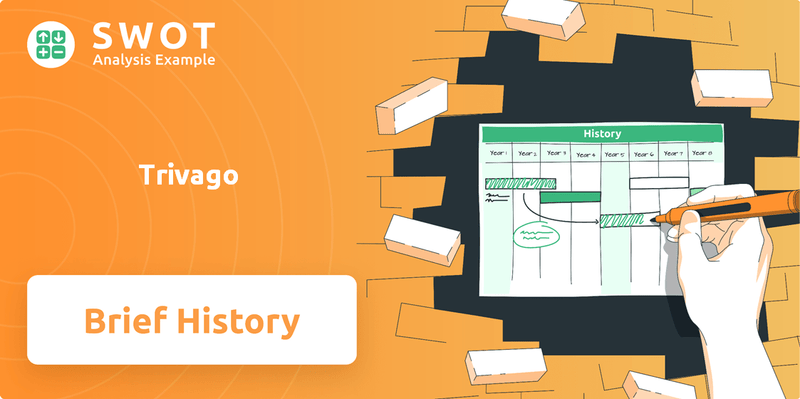
The Trivago company, founded in Düsseldorf, Germany, quickly identified a need for a centralized platform to compare hotel prices. This innovative approach, focusing on hotel search and travel metasearch, allowed Trivago to rapidly gain traction. Its unique business model, avoiding direct hotel inventory, fueled its early growth and positioned it as a key player among its Trivago competitors in the online travel sector.
What is the Trivago Founding Story?
The story of the Trivago company began on January 1, 2005. It was founded by Rolf Schrömgens, Stephan Stubner, and Peter Vinnemeier. Their goal was to simplify the often-complicated process of booking hotels online.
The founders saw a problem: consumers had to visit many different websites to find the best hotel deals. This led to frustration and wasted time. Their solution was a metasearch engine, a tool that would gather hotel offers from various sources and present them in one place.
The name 'Trivago' comes from 'tri' for travel and 'vago' from 'vagabond,' reflecting the spirit of exploration. The founders used their skills in technology, marketing, and business to overcome the challenges of starting an online service in a competitive market. They focused on making hotel prices transparent and easy to compare.
The initial business model revolved around a metasearch engine. This engine aggregated hotel offers from various online travel agencies and hotel chains, providing a comprehensive comparison tool for users.
- The first product was a basic prototype.
- It allowed users to search for hotels in specific locations and compare prices.
- The early version prioritized usability and comprehensive data aggregation.
- The company was initially bootstrapped, relying on the founders' personal capital.
Trivago SWOT Analysis
- Complete SWOT Breakdown
- Fully Customizable
- Editable in Excel & Word
- Professional Formatting
- Investor-Ready Format
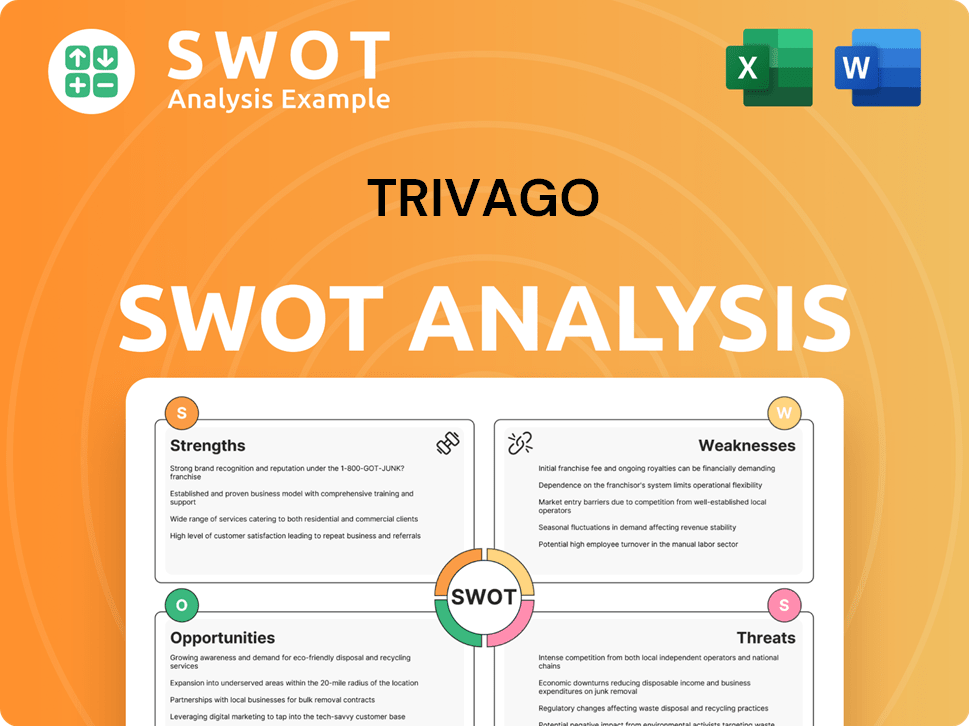
What Drove the Early Growth of Trivago?
The early growth of the Trivago company was marked by a strategic expansion of its hotel database and user base. This growth was fueled by targeted marketing efforts and continuous product improvements. Initially, the focus was on establishing a strong presence in the German market before expanding internationally. Key strategies included enhancing the user interface and improving search algorithms for more accurate results.
Early customer acquisition strategies for Trivago primarily involved online marketing. This included search engine optimization (SEO) and paid search campaigns to attract users actively searching for hotel deals. The company experienced significant user growth, demonstrating the market's positive reception of its price comparison model. This approach was crucial in the early days of the hotel search platform.
The initial team expansion at Trivago was organic, focusing on hiring skilled developers and marketing professionals. These professionals were essential for the platform's technological advancements and market penetration. The first office was established in Düsseldorf, which remains a key operational hub. This early investment in infrastructure supported the company's growth.
A pivotal moment in Trivago's history was its entry into new geographical markets, particularly across Europe and then globally. This internationalization was carefully planned, with localized versions of the platform being launched to cater to diverse linguistic and cultural preferences. This Trivago's growth was a key factor in its success.
In 2012, Expedia Group acquired a majority stake in Trivago for approximately 477 million euros. This acquisition provided significant capital and resources, accelerating its global expansion. This strategic move allowed Trivago to leverage Expedia's network while maintaining its brand identity. To learn more about the ownership, you can read about the Owners & Shareholders of Trivago.
Trivago PESTLE Analysis
- Covers All 6 PESTLE Categories
- No Research Needed – Save Hours of Work
- Built by Experts, Trusted by Consultants
- Instant Download, Ready to Use
- 100% Editable, Fully Customizable
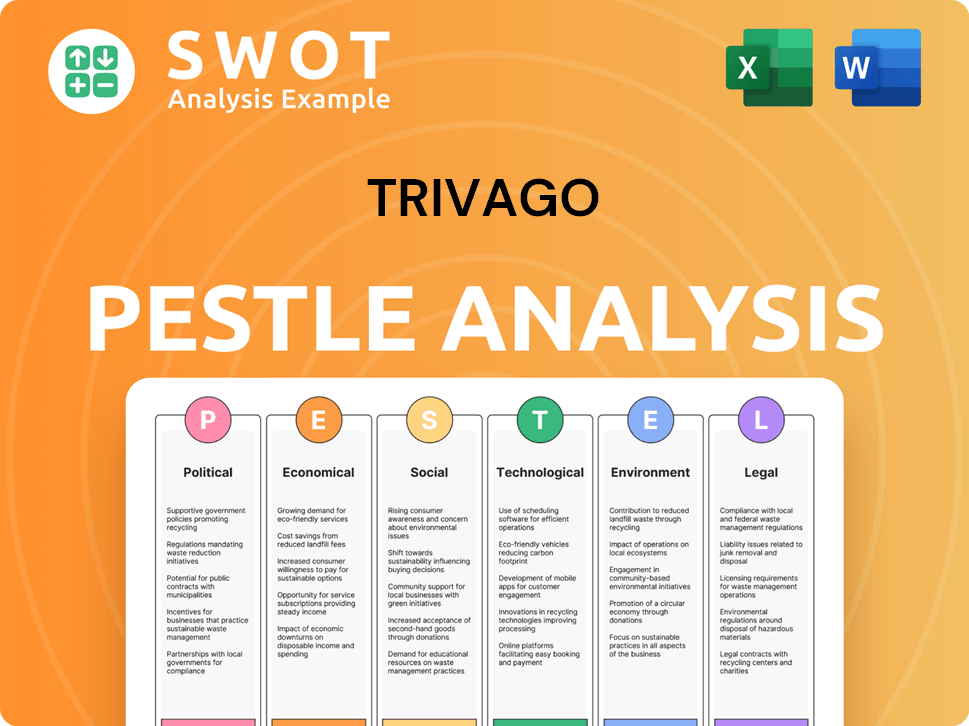
What are the key Milestones in Trivago history?
The Trivago company has a history marked by significant milestones, from its early days to its current status as a leading hotel search platform. The company's journey includes strategic decisions, innovative marketing, and adaptations to the ever-changing online travel landscape. Understanding the Trivago history provides insights into its evolution and impact on the travel metasearch industry.
| Year | Milestone |
|---|---|
| 2005 | Trivago was founded in Düsseldorf, Germany, by Trivago founders Rolf Schrömgens, Peter Vinnemeier, and Stephan Stubner. |
| 2010 | Trivago expanded internationally, establishing a presence in key markets across Europe, North America, and Asia. |
| 2012 | The company launched its first major television advertising campaign, which significantly boosted brand recognition and user acquisition, becoming a key part of Trivago advertising. |
| 2016 | Trivago went public on the NASDAQ, marking a significant step in its growth and financial strategy; the IPO was valued at approximately $287 million. |
| 2019 | The company focused on enhancing its platform with improved features and user experience, including advanced filtering and personalized recommendations. |
| 2020-2021 | Trivago navigated the challenges of the COVID-19 pandemic, adapting its business model and strategies to cope with the sharp decline in travel demand. |
Trivago consistently innovated to improve the user experience on its hotel comparison website. One of the most impactful innovations was the development of its advanced search algorithms, which allowed users to filter and compare hotel options based on various criteria. The platform also introduced user reviews and ratings, providing valuable insights to help travelers make informed decisions.
Trivago pioneered the use of television advertising to build brand awareness, which was instrumental in reaching a broad audience. The memorable 'Hotel? Trivago.' campaign significantly boosted user acquisition globally.
The platform developed sophisticated search algorithms to filter and compare hotel options based on various criteria. This innovation enhanced the user experience and provided more comprehensive information.
Trivago integrated user reviews and ratings, providing valuable insights to help travelers make informed decisions. This feature enhanced the platform's utility and user trust.
The platform began offering personalized recommendations based on user preferences and past searches. This feature improved user engagement and satisfaction.
Trivago invested in mobile app development to cater to the growing number of users accessing the platform on smartphones and tablets. This improved accessibility and user convenience.
The company expanded its database to include a wider range of hotels and accommodation options. This increased the platform's value to users seeking diverse choices.
Trivago has faced several challenges in its history, including market downturns and regulatory scrutiny. The COVID-19 pandemic significantly impacted the travel industry, leading to a decline in hotel bookings and revenue. In the first quarter of 2020, Trivago’s revenue decreased by approximately 10% year-over-year due to the pandemic.
Economic downturns, such as the global financial crisis and the COVID-19 pandemic, significantly impacted the travel industry. These events led to a sharp decline in hotel bookings and revenue for Trivago.
Trivago faced regulatory scrutiny regarding its price comparison practices, leading to legal action and fines in some markets. This prompted a renewed focus on transparency and accuracy in its price comparisons.
Competition from other travel metasearch engines and direct booking channels from hotel chains posed ongoing challenges. Trivago had to continually adapt its strategies to maintain its competitive edge.
The need to continually refine its search algorithms to prioritize user experience and transparency was an ongoing challenge. This required constant adaptation to changing market dynamics.
The company explored new revenue streams beyond its core cost-per-click (CPC) model to diversify its income sources. This was essential for long-term financial stability.
Ensuring the accuracy and transparency of price comparisons was crucial for maintaining user trust. This involved continuous monitoring and improvement of the platform's data.
Trivago Business Model Canvas
- Complete 9-Block Business Model Canvas
- Effortlessly Communicate Your Business Strategy
- Investor-Ready BMC Format
- 100% Editable and Customizable
- Clear and Structured Layout
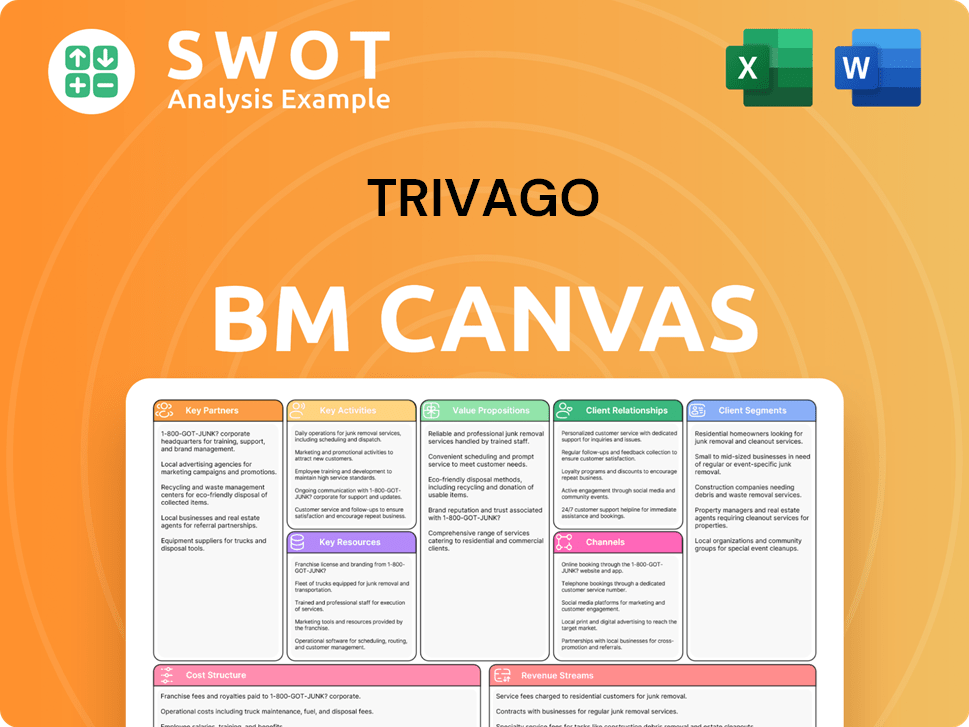
What is the Timeline of Key Events for Trivago?
The Trivago company has a rich history, marked by significant milestones. Founded on January 1, 2005, in Düsseldorf, Germany, it quickly expanded internationally in 2007. A major turning point was the introduction of its first TV advertising campaign in Germany in 2008. In 2012, Expedia Group acquired a majority stake, followed by a global expansion to over 30 countries by 2013. The company went public on NASDAQ in 2016, but faced challenges in 2017 regarding its price comparison practices. The COVID-19 pandemic significantly impacted its revenue in 2020. Despite these challenges, Trivago reported a net income of €39.2 million in 2022 and continues to adapt and optimize its platform.
| Year | Key Event |
|---|---|
| 2005 | Founded in Düsseldorf, Germany. |
| 2007 | Launched its first international platforms. |
| 2008 | Introduced its first TV advertising campaign in Germany. |
| 2012 | Expedia Group acquired a majority stake. |
| 2013 | Expanded its global footprint to over 30 countries. |
| 2016 | Went public on the NASDAQ stock exchange. |
| 2017 | Faced legal challenges regarding its price comparison practices. |
| 2020 | The COVID-19 pandemic significantly impacted the travel industry, leading to a sharp decline in revenue. |
| 2022 | Reported a net income of €39.2 million. |
| 2023 | Continued to focus on optimizing its platform and strengthening partnerships in a recovering travel market. |
| Q1 2024 | Reported revenue of €86.1 million, a decrease of 10% compared to Q1 2023. |
| Q1 2025 | Expected revenue to be between €80 million and €85 million. |
Trivago is concentrating on long-term strategic initiatives. This includes optimizing search algorithms for more personalized hotel recommendations. The company is leveraging artificial intelligence and machine learning to enhance user experience. They are exploring new partnerships to diversify offerings beyond hotel comparisons.
The company is influenced by increasing demand for sustainable travel options. Personalized experiences are also a key trend impacting product development. Trivago aims to adapt to evolving consumer needs and technological advancements. The focus remains on providing a trusted and comprehensive resource for travelers.
Analysts predict a continued focus on profitability and market share. The travel metasearch sector is highly competitive. Leadership emphasizes innovation and delivering value to users and advertisers. The goal is to remain a leader in hotel search.
In Q1 2024, Trivago reported revenue of €86.1 million. The company anticipates revenue between €80 million and €85 million for Q1 2025. These figures reflect ongoing efforts to adapt to evolving market conditions. The company is focusing on sustainable growth.
Trivago Porter's Five Forces Analysis
- Covers All 5 Competitive Forces in Detail
- Structured for Consultants, Students, and Founders
- 100% Editable in Microsoft Word & Excel
- Instant Digital Download – Use Immediately
- Compatible with Mac & PC – Fully Unlocked
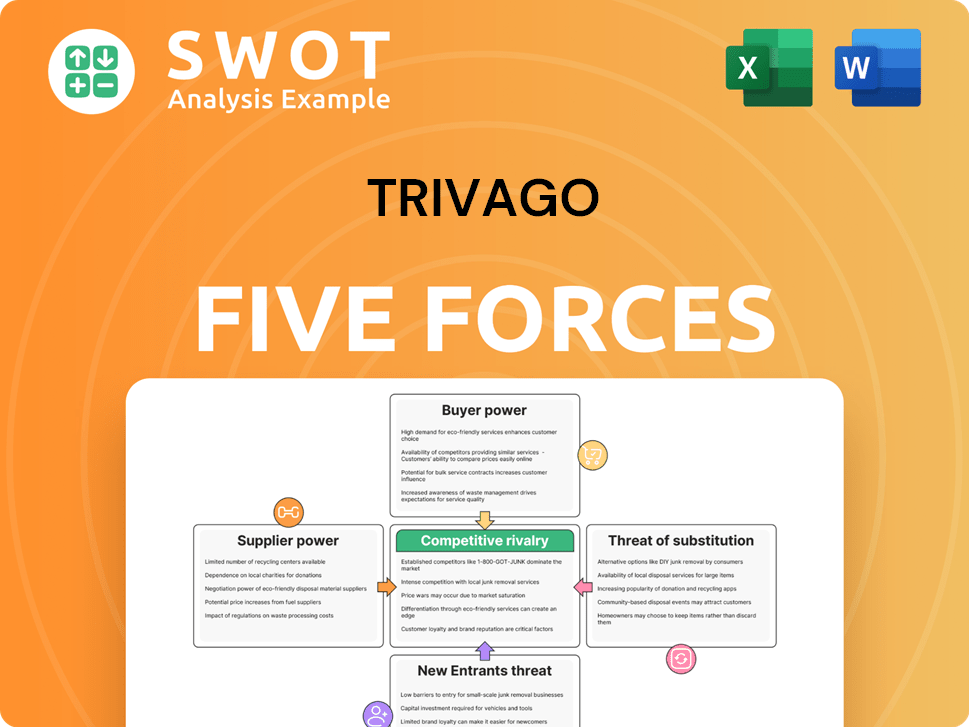
Related Blogs
- What is Competitive Landscape of Trivago Company?
- What is Growth Strategy and Future Prospects of Trivago Company?
- How Does Trivago Company Work?
- What is Sales and Marketing Strategy of Trivago Company?
- What is Brief History of Trivago Company?
- Who Owns Trivago Company?
- What is Customer Demographics and Target Market of Trivago Company?
Disclaimer
All information, articles, and product details provided on this website are for general informational and educational purposes only. We do not claim any ownership over, nor do we intend to infringe upon, any trademarks, copyrights, logos, brand names, or other intellectual property mentioned or depicted on this site. Such intellectual property remains the property of its respective owners, and any references here are made solely for identification or informational purposes, without implying any affiliation, endorsement, or partnership.
We make no representations or warranties, express or implied, regarding the accuracy, completeness, or suitability of any content or products presented. Nothing on this website should be construed as legal, tax, investment, financial, medical, or other professional advice. In addition, no part of this site—including articles or product references—constitutes a solicitation, recommendation, endorsement, advertisement, or offer to buy or sell any securities, franchises, or other financial instruments, particularly in jurisdictions where such activity would be unlawful.
All content is of a general nature and may not address the specific circumstances of any individual or entity. It is not a substitute for professional advice or services. Any actions you take based on the information provided here are strictly at your own risk. You accept full responsibility for any decisions or outcomes arising from your use of this website and agree to release us from any liability in connection with your use of, or reliance upon, the content or products found herein.